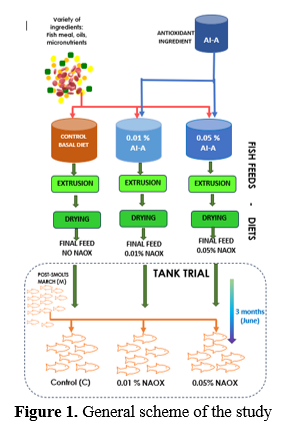NATURAL ANTIOXIDANTS FROM INGREDIENT TO FISH
Introduction
The use of natural antioxidants (NAOX) for preventing fish feed oxidation and reducing oxidative stress in fish is gaining popularity . NAOX present a more sustainable and consumer acceptable alternative to the more traditional, synthetic antioxidants. Further, NAOX contribute to the substitution, or partial replacement of synthetic antioxidants, which is especially relevant following the restriction of e thoxyquin and the anticipated reduction of BHT and BHA.
In order to implement NAOX effectively, i t is imperative to study the behaviour of those compounds with natural antioxidant activity throughout the whole production cycle, from raw materials, through the stages of feed production, to the fish tissues . This project studied the effects of a commercial NAOX ingredient that was added to a commercial fish feed at two levels (0.01 and 0.05%). The objective was to analyze quantitatively selected antioxidant compounds (polyphenols) in various stages of a fish farming process for salmon. Extraction methods for the selected polyphenols were developed for different matrices: antioxidant ingredient, fish feed, and fish tissue and each matrices was analysed by LC-MS/MS. Additionally, for studying the antioxidant effect of the NAOX throughout the production process, several oxidation and oxidative stress indicators were measured; in feed ingredients, in feed at different stages of production, in feed after 3 months storage, and in the tissues of fish fed the two diets.
Materials and Methods
The experimental diets were formulated to meet the nutritional requirements of Atlantic salmon and were produced at the BioMar AS pilot plant. A commercial antioxidant was added at different inclusion levels (0.0, 0.01 and 0.05%). The fish trials were conducted at Matre Aquaculture Station, Institute of Marine Research, Norway. Nine tanks (1×1×0.4 m3) were stocked with 35 post-smolts with an average weight of 473±11 g. Fish in triplicate tanks were randomly assigned to each of the three diets.
The antioxidant ingredient used in the production of the NAOX diet was sampled for analysis . Samples of the three fish feed meals used in the fish trial were also taken before and after extrusion, and after drying (final feed). Several parameters related to feed quality were measured: dry matter, protein, vitamins C and E, astaxanthin, TBARS, total (tGSH) and oxidized (GSSG) glutathione, peroxide value (PV) and anisidine value (AV). Additionally, a LC-MS method established previously was used for the quantitative analysis of the main NAOX compounds in the antioxidant ingredient, in different stages of the production of the 3 diets with different inclusion levels of NAOX (0.0, 0.01 and 0.05%) and in tissue (liver and muscle) of the fish fed the 3 diets.
For the quantitative analysis of the selected NAOX compounds (polyphenols) , extraction of the antioxidant ingredient and the fish feed samples containing different levels of the commercial NAOX ingredient (0, 0.01, 0.05 %) were carried out, as well as at different stages of production (before extrusion, before drying and final feed).
In sampled fish, growth, condition factor, body indices, and cataracts were recorded. Liver and muscle samples were collected and pooled from three fish per tank and analysed for vitamin C, vitamin E, MDA, and astaxanthin. Individual liver and muscle samples from an additional three fish were analysed for GSH/GSSG and antioxidant enzyme analyses. Plasma was taken from all 9 fish and pooled before analysis of vitamin C and vitamin E .
Conclusions
The main NAOX polyphenols were quantified in fish feed ingredients, fish diets at different stages of production, and fish tissues, allowing the complete traceability throughout the pr oduction process. The NAOX content was not stable, an important loss of polyphenols was evidenced, especially during the extrusion process. However, positive results wer e observed in feed, lower TBARS and a protection for tocopherol were observed, as well as a possible protection of astaxanthin.
The analysis of liver and muscle samples, dissected from salmon fed the final feed of the production process, revealed that two polyphenols were transferred into these tissues. Interestingly, and despite of the loss of NAOX during the production of the feed , results from oxidative parameters suggest that dietary NAOX affected MDA and glutathione metabolism in both the muscle and liver of Atlantic salmon: MDA was lowered at 0.01% NAOX in the muscle, while 0.05% was necessary to significantly lower liver MDA. This could indicate that dietary NAOX prevented in vivo lipid oxidation in the fish tissues. GSH and GSSG were lowered in the liver while Eh was constant. In the muscle, GSH increased while GSSG was constant, leading to a more reduced Eh. This shows that redox metabolism was affected by dietary NAOX. No effects of the dietary NAOX were observed on growth, condition factor, body indices or cataracts. The results obtained were promising and further studies are needed for advancing in the understanding of NAOX in redox biology of fish.
NOTE: This work is in parallel/relates to the methods developed and described in the first abstract submitted: 1_Sarmiento et al_V3 : ADVANCES IN THE QUANTIFICATION OF NATURAL ANTIOXIDANTS (NAOX) IN FISH FEED INGREDIENTS BY LC-MS AND CORRELATION WITH ANTIOXIDANT ACTIVITY
